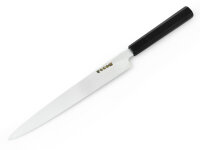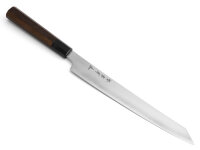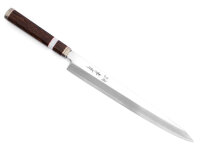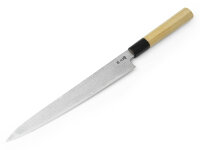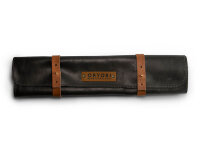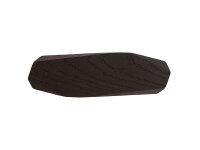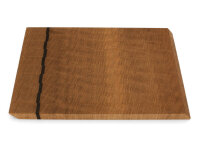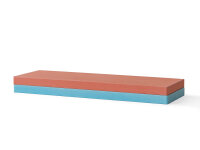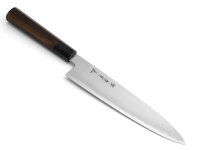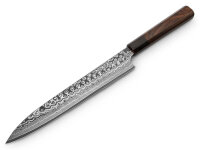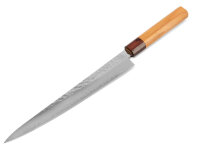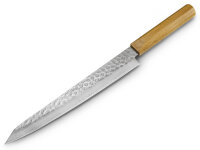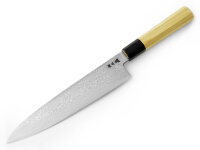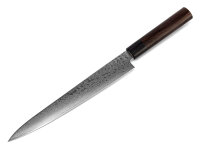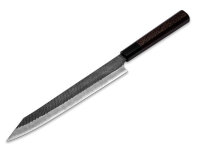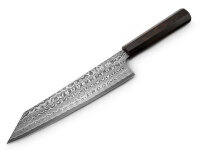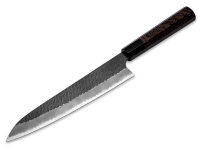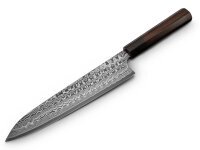"Sakai Takayuki Silver3 Shujihiki 240, Ebony"
Takayuki, chef's knife from Sakai
Kyoto, the old imperial city, is known for its imperial high quality standards. Many connoisseurs regard Kyoto's cuisine as the pinnacle of Japanese culinary art. Not only does it offer a taste that is appreciated worldwide, the artful presentation of the dishes is also a real feast for the eyes. Preference is given to seasonally fresh food. Even during preparation, the self-respecting Japanese chef takes care to treat the food in such a way that it can show off its freshness in color and texture.
Sakai was called the Venice of the East at the beginning of the 16th century. As an important trading town, Sakai was one of the most prosperous cities in Asia. People from all over the world and all cultures met here with their products and knowledge. \"Everything new was born in Sakai\" and the traders and craftsmen took it back to other regions of Japan and inspired the people there.
Kitchen knives from the SAKAI TAKAYUKI brand
Japanese swords are a status symbol of antiquity. The blades were created by the swordsmiths by folding and forging a carefully selected steel over and over again. The ancient blacksmithing skills of Japan resulted in unprecedentedly brilliant and sharp blades. The whole of Japan is proud of this traditional craft of master craftsmen. And the now worldwide distribution and appreciation of Japanese kitchen knives shows that Japan is rightly proud. Japanese kitchen knives have a number of peculiarities, from the steel and workmanship to the shapes. Basically, they were created to cut delicate food very finely. This task is typical of Japanese cuisine, which attaches almost as much importance to the art of presenting food in an appetizing, decorative way as it does to excellent taste. SAKAI TAKAYUKI kitchen knives are made in the spirit of the old tradition and represent the exceptional skills of the Japanese masters. This traditional brand includes modern kitchen knives made of stainless steel and, of course, Hocho, the traditional Japanese knives. SAKAI knives are subject to the special quality standards of this knife city. A cooperative strictly ensures that only chef's knives that meet the specified quality characteristics are offered as SAKAI knives.
Instructions for use
Japanese chef's knives are made from extremely hard steels and are forged and ground thinner than their European counterparts. Some of these knives have very finely ground cutting edges, making them more delicate and only suitable for soft cuts. Please note the relevant information in the product details. Knives with a very thin cutting edge and hollow grind are particularly prone to chipping on the blade. These are ideal for fine cuts of soft food, but should be used with appropriate care. Sharpening on a whetstone usually produces an angled grind, which makes the edge more stable over time.
Chipping on the cutting edge can also be caused by leverage and frozen cuttings, which significantly reduce the temperature of the steel. Leverage forces often occur when cutting material with bones, for example. Chips on the cutting edge may need to be ground out by a specialist.
The knife should always be guided in a straight line with a pulling or pushing cut, without applying great pressure. To maintain sharpness, avoid cutting on stone, glass or other hard surfaces. Never use \"sharpening steel\" for resharpening. Water whetstones are recommended (grit: 400-1200 for pre-sharpening, 3000 for fine sharpening, 6000 or more to hone the blade) and, if necessary, a honing leather.Please keep the knife away from children. These knives are extremely sharp, please be careful.
All products are unique, slight deviations from the exemplary illustration are therefore possible.
Care instructions
When using knives made of sensitive steel types, such as Aogami, Shirogami or V-Toku, please clean them occasionally with a cloth and water, even during prolonged use. However, acidic foods can still cause discoloration on these classic carbon steels. After use, please wash by hand with hot water and use a neutral detergent if necessary. Never put the knife in the dishwasher. After cleaning, dry thoroughly, oil if necessary and store in a well-ventilated place. Residual moisture can cause rust on non-stainless steels. Please refer to our articles in the ORYOKI Japan blog on product care.
Clean the knife by hand and do not use a dishwasher. Dry it thoroughly afterwards.

